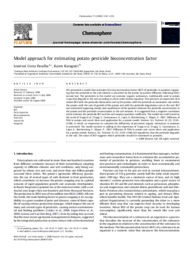Model approach for estimating potato pesticide bioconcentration factor.
Model approach for estimating potato pesticide bioconcentration factor.
Autoria: PARAIBA, L. C.; KATAGUIRI, K.
Resumo: e presented a model that estimates the bioconcentration factor (BCF) of pesticides in potatoes supposing that the pesticide in the soil solution is absorbed by the potato by passive diffusion, following Fick?s second law. The pesticides in the model are nonionic organic substances, traditionally used in potato crops that degrade in the soil according to a first-order kinetic equation. This presents an expression that relates BCF with the pesticide elimination rate by the potato, with the pesticide accumulation rate within the potato, with the rate of growth of the potato and with the pesticide degradation rate in the soil. BCF was estimated supposing steady state equilibrium of the quotient between the pesticide concentration in the potato and the pesticide concentration in the soil solution. It is suggested that a negative correlation exists between the pesticide BCF and the soil sorption partition coefficient. The model was built based on the work of Trapp et al. [Trapp, S., Cammarano, A., Capri, E., Reichenberg, F., Mayer, P., 2007. Diffusion of PAH in potato and carrot slices and application for a potato model. Environ. Sci. Technol. 41 (9), 3103? 3108], in which an expression to calculate the diffusivity of persistent organic substances in potatoes is presented. The model consists in adding to the expression of Trapp et al. [Trapp, S., Cammarano, A., Capri, E., Reichenberg, F., Mayer, P., 2007. Diffusion of PAH in potato and carrot slices and application for a potato model. Environ. Sci. Technol. 41 (9), 3103?3108] the hypothesis that the pesticide degrades in the soil. The value of BCF suggests which pesticides should be monitored in potatoes.
Ano de publicação: 2008
Tipo de publicação: Artigo de periódico
Unidade: Embrapa Meio Ambiente
Palavras-chave: Agrotóxico, Modelagem matemática
Observações
1 - Por padrão são exibidas publicações dos últimos 20 anos. Para encontrar publicações mais antigas, configure o filtro ano de publicação, colocando o ano a partir do qual você deseja encontrar publicações. O filtro está na coluna da esquerda na busca acima.
2 - Para ler algumas publicações da Embrapa (apenas as que estão em formato ePub), é necessário ter, no celular ou computador, um desses softwares gratuitos. Sistemas Android: Google Play Livros; IOS: iBooks; Windows e Linux: software Calibre.
Acesse outras publicações
Acesse a Base de Dados da Pesquisa Agropecuária (BDPA) para consultar o acervo completo das bibliotecas da Embrapa.

